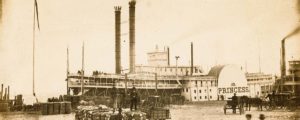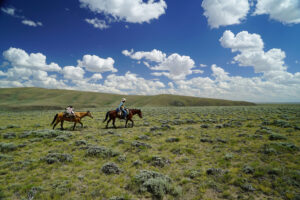Dr. Robert F. McMurtry and Robert Beal founded Ingalls during Oklahoma’s first land rush, into the Unassigned Lands on April 22, 1889. It was named for Kansas Senator John J. Ingalls, who helped pass the legislation opening future Oklahoma Territory.
Oklahoma historian Glenn Shirley wrote, “There seemed no reason for [Ingalls’] birth.” McMurtry and Beal hoped a proposed railroad would come to the town, but it never did. Still, the town initially thrived as a mail center and supply depot for local cotton and grain farmers.
The town grew to 16 blocks, with 100-foot-wide streets and 20-foot-wide alleys. The four east-west streets were numbered from the north: First, Second, Third and Fourth. The four north-south streets, beginning from the west, were Main, Walnut, Ash and Oak. Soon the frontier settlement included a handful of doctors, two blacksmith shops, a barbershop, a dry goods store, a hardware store, a boot shop, a gristmill, general stores, livery stables and the Ransom and Murray Saloon. The sole two-story structure was the O.K. Hotel, run by Mary Pierce.
In 1891 Ingalls’ school boasted 40 students, and a city well was installed at the main intersection of Ash and Second. In 1893 the Oklahoma Hawk made a bold prediction: “Ingalls will be a city when the balloon towns of the west have exploded.”
The presence of a gaming parlor, brothel and well-stocked saloon, along with Ingalls’ close proximity to the wild and rugged Creek Nation, soon attracted the Doolin-Dalton Gang. Bill Doolin secretly married Ingalls resident Edith Ellsworth, daughter of the postmaster.
On September 1, 1893, two wagons full of deputy sheriffs disguised as homesteaders descended on Ingalls. Federal officer Red Lucas, reported that Doolin, Bill Dalton, Bitter Creek Newcomb, Tulsa Jack Blake, Red Buck Waightman and Dynamite Dick Clifton were bellied up to the bar in the Ransom Saloon. He could not locate Arkansas Tom Jones. The 13 lawmen entered town and scattered to cut off all avenues of escape. When Newcomb stepped outside for some air, Deputy Sheriff Dick Speed shot at him, and the battle began. Jones was in a room on the top floor of the O.K. Hotel—a perfect vantage point—and fired fatal Winchester rounds into Speed, Tom Hueston and Lafe Shadley. Stray bullets killed two of Ingalls’ citizens and wounded two more. Among the outlaws, Newcomb was shot through the leg and Clifton caught a bullet in the neck, but all who had been in the saloon managed to escape, abandoning Jones to capture. Some residents, incensed at the deputy sheriffs’ brazen ambush, even helped the outlaws to escape.
After the Battle of Ingalls, the town was better known, but that wasn’t enough to keep it from going downhill. Some travelers avoided the place because of its reputation for harboring outlaws, and when the railroads went elsewhere, it began a permanent decline. Still, well into the 20th century, many area residents continued to take pride in Ingalls’ outlaw-lawman history. In 1938, when the state erected a monument to the deceased lawmen, one old-timer was noted as saying, “They built it for the wrong side.” Though it experienced a short-lived oil boom, the town’s final demise occurred when U.S. Highways 51 and 108, to the north and west respectively, failed to bisect Ingalls. Ingalls now has few businesses, and only two dozen people live there today.
Originally published in the October 2007 issue of Wild West. To subscribe, click here.




